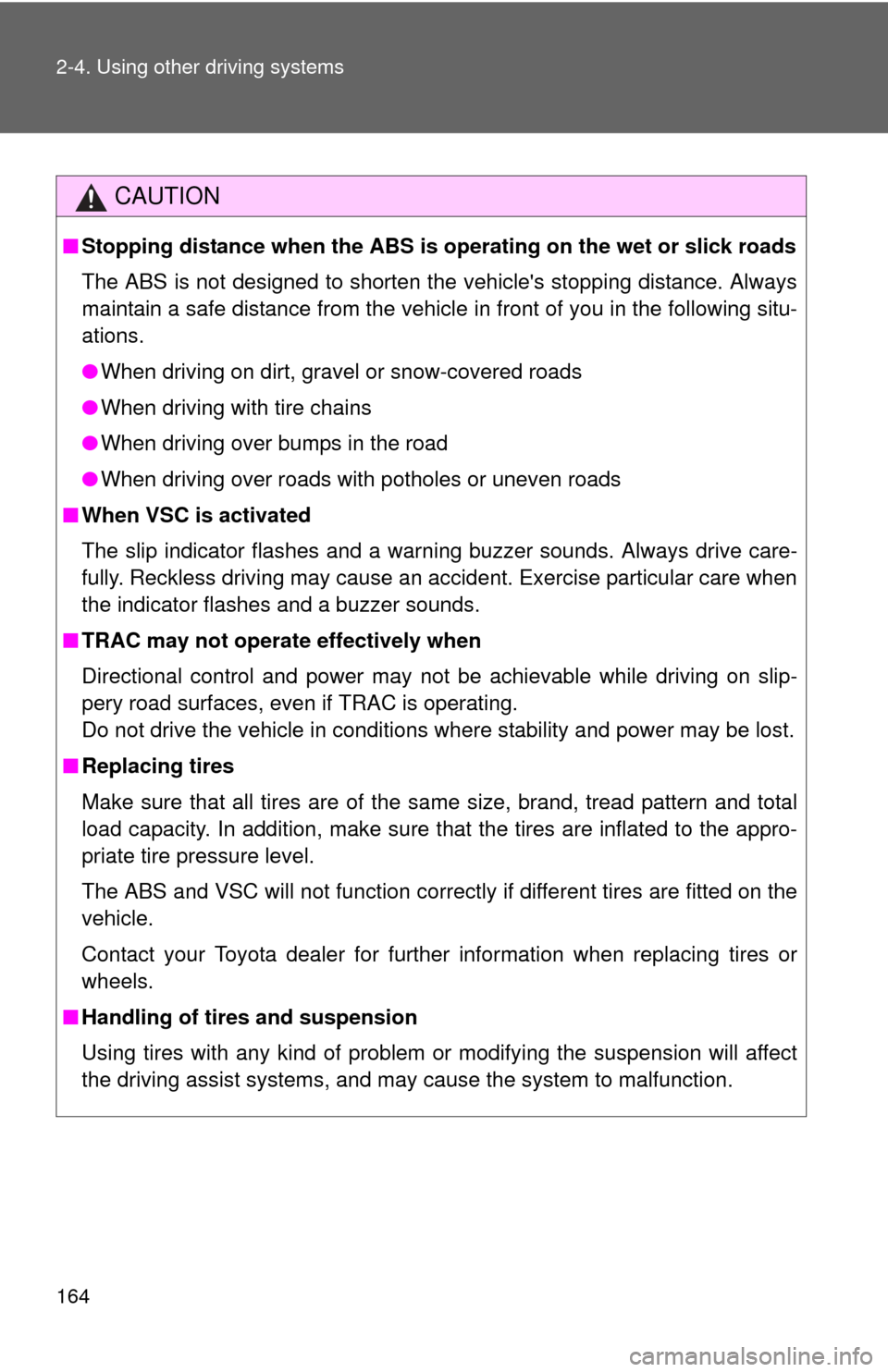Page 1 of 400
TABLE OF CONTENTS
1
1Before drivingAdjusting and operating features such as door locks,
mirrors, and steering column.
2When drivingDriving, stopping and safe-driving information.
3Interior
featuresAir conditioning and audio systems, as well as other in-
terior features for a comfortable driving experience.
4Maintenance
and careCleaning and protecting your vehicle, performing do-it-
yourself maintenance, and maintenance information.
5When trouble
arisesWhat to do if the vehicle needs to be towed, gets a flat
tire, or is involved in an accident.
6Vehicle
specificationsDetailed vehicle information.
7For ownersReporting safety defects for U.S. owners and seat belt
instructions for Canadian owners
IndexAlphabetical listing of information contained in this
manual.
Page 4 of 400

TABLE OF CONTENTSIndex
4
4-3. Do-it-yourself maintenance
Do-it-yourself service
precautions ...................... 247
Hood................................... 250
Positioning a floor jack ....... 251
Engine compartment .......... 253
Tires ................................... 266
Tire inflation pressure......... 272
Wheels ............................... 276
Air conditioning filter ........... 278
Key battery ......................... 281
Checking and replacing
fuses ................................ 283
Light bulbs .......................... 294
5-1. Essential information
Emergency flashers ........... 304
If your vehicle needs to be
towed ............................... 305
If you think something is
wrong ............................... 311
Fuel pump shut off
system .............................. 312
Event data recorder............ 3135-2. Steps to take in an emergency
If a warning light turns on
or a warning buzzer
sounds... ........................... 315
If you have a flat tire ........... 325
If the engine will not start .... 337
If the shift lever cannot be
shifted from P ................... 339
If you lose your keys ........... 340
If the vehicle battery is
discharged ........................ 341
If your vehicle overheats..... 345
If the vehicle becomes
stuck ................................. 348
If your vehicle has to be
stopped in an
emergency........................ 350
6-1. Specifications
Maintenance data
(fuel, oil level, etc.) ........... 352
Fuel information .................. 361
Tire information................... 364
6-2. Customization
Customizable features ........ 377
Items to initialize ................. 379
5When trouble arises
6Vehicle specifications
Page 7 of 400
7
Tires
●Rotation
●Replacement
●Inflation pressure
●Information
P. 266
P. 325
P. 272
P. 364
: If equipped
Back door P. 36Side doors P. 31
Fuel filler door P. 74
Rear turn signal lights P. 135
Rear window defoggerP. 193
License plate light P. 149
Stop/tail and rear side
marker lights
P. 149
Rear window wiperP. 155
Page 9 of 400
9
Tires
●Rotation
●Replacement
●Inflation pressure
●Information
P. 266
P. 325
P. 272
P. 364
: If equipped
Back door P. 36Side doors P. 31
Fuel filler door P. 74
Rear turn signal lights P. 135
Rear window defoggerP. 193
License plate light P. 149
Stop/tail and rear side
marker lights
P. 149
Rear window wiperP. 155
Page 128 of 400

128 2-1. Driving procedures
NOTICE
■Avoiding damage to vehicle parts
●Do not turn the steering wheel fully in either direction and hold it there for a
long time.
Doing so may damage the power steering motor.
●When driving over bumps in the road, drive as slowly as possible to avoid
damaging the wheels, underside of the vehicle, etc.
■If you hear a squealing or scraping noise while driving (brake pad wear
limit indicators)
Have the brake pads checked and replaced by your Toyota dealer as soon
as possible.
The rotor damage can result if the pads are not replaced when needed.
It is dangerous to drive the vehicle when the wear limits of the brake pads
and/or that of the brake discs are exceeded.
■If you get a flat tire while driving
A flat or damaged tire may cause the following situations. Hold the steering
wheel firmly and gradually press the brake pedal to slow down the vehicle.
●It may be difficult to control your vehicle.
●The vehicle will make abnormal sounds.
●The vehicle will behave abnormally.
Replace a flat tire with a new one. (P. 328)
■When encountering flooded roads
Do not drive on a road that has flooded after heavy rain etc. Doing so may
cause the following serious damage to the vehicle.
●Engine stalling
●Short in electrical components
●Engine damage caused by water immersion
In the event that you drive on a flooded road and the vehicle is flooded, be
sure to have your Toyota dealer check the following.
●Brake function
●Changes in quantity and quality of engine oil, transaxle fluid, etc.
●Lubricant condition for the bearings and suspension joints (where possi-
ble) and the function of all joints, bearings, etc.
Page 164 of 400

164 2-4. Using other driving systems
CAUTION
■Stopping distance when the ABS is operating on the wet or slick roads
The ABS is not designed to shorten the vehicle's stopping distance. Always
maintain a safe distance from the vehicle in front of you in the following situ-
ations.
●When driving on dirt, gravel or snow-covered roads
●When driving with tire chains
●When driving over bumps in the road
●When driving over roads with potholes or uneven roads
■When VSC is activated
The slip indicator flashes and a warning buzzer sounds. Always drive care-
fully. Reckless driving may cause an accident. Exercise particular care when
the indicator flashes and a buzzer sounds.
■TRAC may not operate effectively when
Directional control and power may not be achievable while driving on slip-
pery road surfaces, even if TRAC is operating.
Do not drive the vehicle in conditions where stability and power may be lost.
■Replacing tires
Make sure that all tires are of the same size, brand, tread pattern and total
load capacity. In addition, make sure that the tires are inflated to the appro-
priate tire pressure level.
The ABS and VSC will not function correctly if different tires are fitted on the
vehicle.
Contact your Toyota dealer for further information when replacing tires or
wheels.
■Handling of tires and suspension
Using tires with any kind of problem or modifying the suspension will affect
the driving assist systems, and may cause the system to malfunction.
Page 175 of 400

175 2-5. Driving information
2
When driving
■Before towing
Check that the following conditions are met:
●Ensure that your vehicle’s tires are properly inflated. (P. 359)
●Trailer tires should be inflated according to the trailer manufacturer’s rec-
ommendation.
●All trailer lights work to be legal.
●Confirm all lights work each time you connect them.
●Check that your vehicle remains level when a loaded or unloaded trailer
is hitched. Do not drive if the vehicle is not level, and check for improper
tongue load, overloading, worn suspension, or other possible causes.
●Make sure the trailer cargo is securely loaded.
●Check that your rear view mirrors conform to any federal, state/provincial
or local regulations. If they do not, install rear view mirrors appropriate for
towing purposes.
■Break-in schedule
●Toyota recommends that you do not use a new vehicle or a vehicle with
any new power train components (engine, transmission, differential,
wheel bearings, etc.) to tow a trailer for the first 500 miles (800 km) of
driving.
■Maintenance
●If you tow a trailer, your vehicle will require more frequent maintenance
due to the additional load. (See “Scheduled Maintenance Guide” or
“Owner’s Manual Supplement”.)
●Retighten the fixing bolts of the towing ball and bracket after approxi-
mately 600 miles (1000 km).
Page 235 of 400
Maintenance and care4
235
4-1. Maintenance and care
Cleaning and protecting
the vehicle exterior......... 236
Cleaning and protecting
the vehicle interior.......... 238
4-2. Maintenance
Maintenance
requirements .................. 241
General maintenance....... 243
Emission inspection and
maintenance (I/M)
programs........................ 2464-3. Do-it-yourself maintenance
Do-it-yourself service
precautions .................... 247
Hood ................................ 250
Positioning a floor jack ..... 251
Engine compartment ........ 253
Tires ................................. 266
Tire inflation pressure ...... 272
Wheels ............................. 276
Air conditioning filter......... 278
Key battery ....................... 281
Checking and replacing
fuses .............................. 283
Light bulbs........................ 294